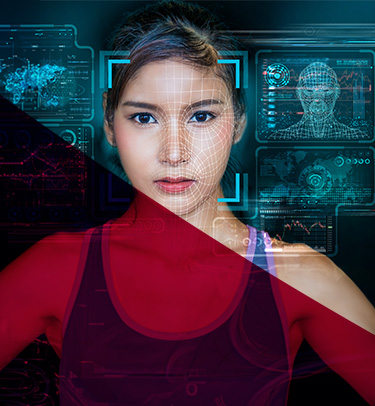Imagine effortlessly boarding a plane without having to fumble for your passport or ticket, or experiencing the convenience of automated check-ins at hotels.
From enhancing security measures to revolutionising healthcare, facial recognition has a broad range of applications that are transforming various industries. In this article, we will explore the mechanics of facial recognition, and explore how machine learning aids computer vision to identify faces.
The Science Behind the Smile: How Facial Recognition Works
Facial recognition is a sophisticated technology capable of identifying or verifying a person from a digital image or video frame. It leverages advanced algorithms and machine learning to accurately identify or verify individuals. It’s a fascinating example of computer vision, a field of artificial intelligence that enables machines to interpret and understand the visual world.
- Image Capture and Analysis: The process begins with capturing a facial image using a camera or video feed. This image is then converted into digital data that can be processed by algorithms.
- Feature Extraction: Sophisticated algorithms analyse the image and extract distinctive facial landmarks and measurements. These features can include the distance between the eyes, the shape of the nose, the contours of the cheekbones, and numerous other facial characteristics. These unique features create a sort of "facial fingerprint" for each individual.
- Matching and Verification: The extracted features are then compared against a database of known faces. This database can contain images of individuals, such as employees in a company or citizens in a national database. The algorithm calculates the similarity between the input image and the stored faces, determining a match or verifying an identity.
Machine Learning's Magic: Training the System to Recognise Faces
The true power of facial recognition isn't just in its ability to capture and compare faces – it's in its capacity to learn and improve over time. This is where machine learning steps in, acting as the brain behind the system's impressive accuracy, even when faced with tricky lighting or a change in someone's hairstyle.
So, how does this learning happen?
- Data is the Teacher: The system is fed a massive diet of labelled facial images. We're talking millions of photos, each carefully tagged with details about the person – their name, age, gender, and so on. It's like showing a child countless pictures of apples and oranges until they can tell the difference on their own.
- Neural Networks: The heart of the learning process is the neural network, a complex structure inspired by the human brain. It sifts through the data, identifying patterns and unique features in each face – the distance between the eyes, the curve of the jawline, and countless other tiny details that make you, you.
- Diversity Matters: To avoid bias and ensure everyone is recognized accurately, the training data needs to be as diverse as the real world. Imagine if the system only saw pictures of people with one skin tone or hair type - it would struggle to recognize anyone outside that narrow group.
- Learning Never Stops: The beauty of machine learning is that it's always improving. As the system encounters new faces and gets feedback on its performance, it tweaks its machine-learning algorithms, getting better and better at its job. It's like a student who never stops studying, constantly refining their understanding.
Real-World Applications of Facial Recognition
The applications of facial recognition are far-reaching and continue to expand across various sectors:
- Security and Surveillance: Facial recognition is employed in law enforcement to identify suspects and track individuals in crowded areas. It is also used in access control systems to grant entry to authorised personnel and in airports for security checks. This technology is a powerful tool for enhancing security and safety.
- Healthcare: In the medical field, facial recognition assists in diagnosing genetic disorders by analysing facial features. It can also monitor patient well-being by detecting changes in facial expressions and even aid in surgery by providing real-time guidance to surgeons. These applications demonstrate the potential of facial recognition to revolutionise healthcare.
- Retail and Marketing: Retailers utilise facial recognition for targeted advertising and personalised shopping experiences. It can also be used to track customer behaviour and prevent theft. By understanding customer demographics and preferences, businesses can tailor their offerings and improve the overall shopping experience.
- Finance: Financial institutions leverage facial recognition for secure online banking and payment transactions, adding an extra layer of protection against fraud. Biometrics provide a more secure and convenient way to verify identity compared to traditional methods like passwords or PINs.
- Entertainment: The entertainment industry employs facial recognition for interactive games, virtual reality experiences, and personalised content recommendations. By analysing facial expressions, these technologies can enhance user engagement and create immersive experiences.
Learn Machine Learning and Facial Recognition Technology at PSB Academy
At PSB Academy, we are proud to offer the Bachelor of Engineering (Hons) in Robotics and Artificial Intelligence in collaboration with the University of Hertfordshire. This programme provides students with a comprehensive curriculum that explores the latest advancements in robotics and artificial intelligence, preparing them for exciting careers in this rapidly growing field.
The programme is structured to provide students with a strong foundation in both theoretical and practical aspects of robotics and AI. Students will gain a deep understanding of robotics principles, robot design, and control systems, as well as machine learning algorithms, data analysis, and computer vision.
One of the highlights of the programme is the opportunity for students to work with the Alpha Mini robot, a humanoid robot equipped with facial recognition software. This hands-on experience allows students to apply their theoretical knowledge to real-world applications, programming the robot to perform various tasks and interact with users in everyday life.
Ready to embark on an exciting journey into the world of AI and robotics? Explore the Bachelor of Engineering (Hons) in Robotics and Artificial Intelligence in collaboration with the University of Hertfordshire or other PSB Academy engineering courses today!




 TOP
TOP





